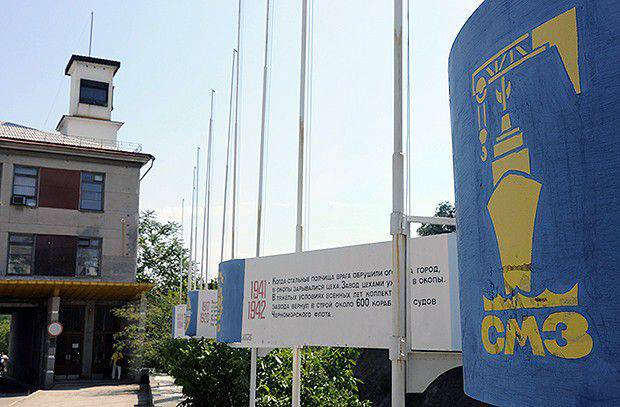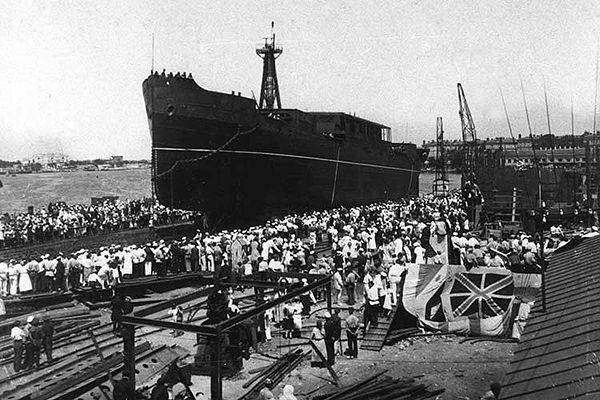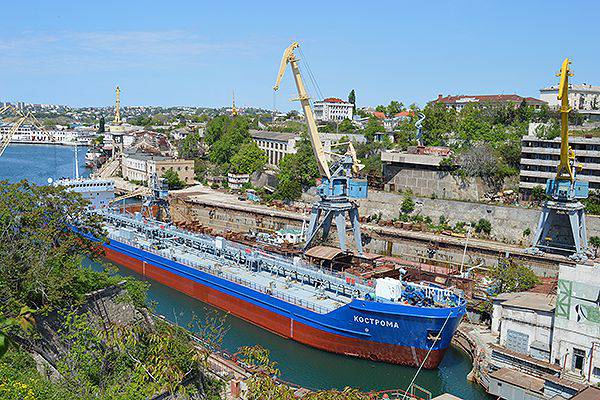"We are devoted to these stones to infinity"

History, fate and prospects of the Sevastopol Marine Plant
For the first time since the 90's, the Sevastopol Marine Plant will repair military ships and build civilians - this is what its specialists are best at and how it was built. How the plant survived in the Crimean, Civil, World War II, but could not stand the privatization and redistribution of assets in Ukraine, and who will restore it now, the correspondent of "Russian Planet".
Times of the conquest of the Crimea
“The Sevastopol Marine Plant originates from the Sevastopol Admiralty,” the director of the plant’s museum Irina Shestakova tells the correspondent of the Russian Planet. - He appeared simultaneously with the city and the Black Sea fleet. After the arrival of the first squadron on the western shore of the South Bay, the first buildings of the city and the Admiralty were laid: a chapel in the name of Nicholas the Wonderworker, a house for the commander, a marina and a forge for repairing the ships that arrived. The laying date of these four buildings, June 14, 1783, became the founding date of the city and the Sevastopol Admiralty - the predecessor of the Sevastopol Marine Plant.
Initially, the plant originated as a ship repair enterprise, but already after 12 years after its foundation, the first two schooners were built under the numbers 1 and 2. Before the Crimean War, the plant built more 50 sailing ships. They investigated the Black Sea, carried patrol service, participated in sea battles.
The brig Mercury became the most legendary ship. It was built in the 1820 year, and in the 1829, during the Russo-Turkish War, it won an unequal battle with two Turkish battleships, ten times superior to the brig in crew numbers and artillery weapons. The monument on Matrossky Boulevard to the commander, lieutenant commander Kazarsky, in honor of the feat of the brig team with the inscription “To posterity as an example” is the first monument erected in Sevastopol.
Another legendary ship, the “Olivuts” corvette, at one time made a voyage around the world, proving to the whole world that sturdy ships are being built in Sevastopol.
- During the Crimean War, Russian commanders gave the order to scuttle ships, so that the enemy fleet could not enter the bay. Many people were against such a decision. Sailors rushed into battle, but the order was still executed. After the end of the Crimean War, Russia signed the Treaty of Paris, under the terms of which it was deprived of the right to have a navy on the Black Sea. The plant was leased to the Russian Shipping Company and Trading Company (ROPIT) joint-stock enterprise and began to work for civilian purposes, adds Shestakova.
During one of the Russian-Turkish wars, the steamships were re-equipped and armed. They fought large Turkish ships and won victories. After Russia's victory over Turkey in 1871, the Treaty of Paris was annulled, sanctions lifted, and Russia resumed building warships on the Black Sea.
“Squadron battleships, the first destroyers Chesma and Sinop were built, new docks were built to repair ships, which in their technical and operational characteristics were superior to similar facilities in other countries,” says the museum director.
In those years, the famous Ochakov armored cruiser with new powerful mechanisms, boilers and weapons was built, and the battleship Potemkin was completed, during which the first uprising in the Black Sea Fleet led by Lieutenant Schmidt took place in June 1905.
During the Civil War, the main fleet of the plant was taken abroad, and ships that were not capable of long crossings were blown up. After the Civil War, they began to recover.
In the first five-year plan, the factory resumed the production of civilian ships. The timber carrier “Mikhail Frunze” was built, as well as passenger ships, tugs, schooners. By the 1940 years, great attention was paid to the repair of warships again.

“The cargo steamer Kharkov carried peas,” says the museum director. - In the area of the Bosphorus, he ran aground and struck the hull. The peas got wet from the water, and the ship tore in half. But our factory workers connected its two parts and repaired it. So there was a saying that this is the longest ship in the world: the bow in Sevastopol, and the feed in Constantinople.
"We repaired the ship in the light of lighting bombs"
During World War II, the Germans mined the Sevastopol bays with electromagnetic mines. To solve this problem, a team of scientists led by Academician Igor Kurchatov arrived in the city. Together with the factory workers, they created a device for degaussing ship hulls, thanks to which ships could leave the bay and participate in battles.
- In our factory, a floating anti-aircraft battery was equipped, which is popularly called “Don't touch me.” She hit over 20 enemy aircraft - continues Shestakova. - They also built three armored trains: "Sevastopolets" and "Ordzhonikidze" were sent to the north, and "Zheleznyakov" fired at enemy positions in the area of the Mekenziy Mountains. Now you can see it at the bus station.
The plant itself was partially evacuated during the war. The first wave is in the Caucasus, in Tuapse, later in the cities of Poti and Batumi. Part of the production, remaining in Sevastopol, was placed in underground galleries.
“I came to the factory right after school,” says RP Veteran Vladimir Rimmer, who was evacuated to the Poti war. - When the war started, I was only 15 years old. My mother and baby were evacuated to the north, and my brother and I were sent to a secret base located on the Hopi River. From the age of 15 I was in a combat situation. He carried the border guard service for the protection of the water region from Poti to Turkey. From the protective uniforms we had a helmet and a vest with metal on my stomach. At the same time, we had to run fast and maneuver. Here the bomb will fall, then here. There was a constant danger that the German aviation begins to bomb us from the air and enemy submarines, which occupied positions in the Poti region, can also destroy our ship. We were drowned twice. In order to survive, we repaired the ship in the light of light bombs. We miraculously managed to escape, they dragged us in tow.
In 1954, from Poti Vladimir Rimmer was transferred back to Sevastopol to Sevmorzavod, where he worked until 2012.
In the 50s, the factory continued to repair the ships - not only the military, but also civilians, whaling ships - and they began to build them anew. In 60, the Chernomorets 100 tonics were built here, and Bogatyr 70 tonics were built in the 300. The plant worked not only for the USSR, but also for other countries of the social camp — Bulgaria, Poland, Romania, and the GDR.

In 1974, the floating cranes “Bogatyr” and “Chernomorets” were awarded the State Quality Mark. In 1978, the floating Vityaz crane with a load capacity of 1600 tons was built. It was made by special order for the construction of a dam with a complex for the passage of vessels - to protect Leningrad from flooding. In total, more than 70 various floating cranes were built on the plant during its operation.
In addition to industrial products, in Soviet times, the factory produced and consumer goods.
- We produced metal garages, kitchen sets, beds, travel bags, backpacks, tents, souvenir badges, sectional furniture and much more. Production was closed only in 90's, says Irina Shestakova.
"In one day there was no work"
“My father, husband, I, our children and grandchildren worked at this factory,” former plant designer Galina Karpova tells the Russian Planet correspondent. - We are simply devoted to these stones to infinity. This is our refuge, our memory and our pain. We received everything from the plant: education, apartments ... The plant is our whole life. At one time it numbered over 12 thousands of employees, and this is without taking into account contractors and subcontractors. The designers admired locksmiths, they had golden hands. We had our own pioneer camp, recreation center, clinic. The plant participated in the construction of the stadium "Chaika", and now it sells fruit. We look forward to his rebirth.
- How did the state enterprise become a joint-stock company? - I am interested in the former plant manager, Anatoly Cherevaty, who came to the plant back in 1962 year.
- After the collapse of the Union, we didn’t have any work in one day. Everyone came to work, and it turned out that the plant did not have a single order funded. In Soviet times, the factory was actually on 100% secured by government orders. But in Ukraine measures were not taken to load industrial enterprises of the military-industrial complex. The executive authorities answered questions from enterprises: “The state builds the economy on market principles. The market will answer all your questions. Dive into the competitive world system and solve problems you have yourself. ”
In essence, says Cherevaty, defense industry enterprises were left to the mercy of fate. At the same time, the legislative field of Ukraine in the field of economic activity imposed on their leadership large restrictions in making commercial and other economic decisions.
In 1995, the plant became a joint stock company with an 100-percentage stake in state-owned shares. By the way, the first among the shipyards of Ukraine.
- We have traveled literally half the world, proving to potential customers that there is such a ship repair plant and that it offers competitive terms for the fulfillment of contracts. In order to resume work with Russia, we organized a Russian-Ukrainian joint venture Lazarevskoye Admiralty, in which the controlling stake belonged to a Russian partner. Having obtained the necessary licenses, the enterprise became the participant of tenders of the Ministry of Defense of the Russian Federation, and thus the ships of the Black Sea Fleet of the Russian Federation began to repair.
Having received the status of JSC, the company gradually rose to its feet. Machine builders mastered new types of products, shipbuilders repaired foreign ships from Bulgaria, Greece, Turkey, Lebanon, Malta, Cyprus and other countries. The plant continued to build floating cranes, among which Feodosiets and Sevmorneftegaz, began to develop new ships: a transport dock platform for landing ships of the Zubr type, a unique fire vessel Pivdenny for the port of Yuzhny, a non-propelled floating loading crane. "Atlas", boat bonopostovschikov-skimmer.
- In 1997, the privatization sale of parts of the state-owned shares of the plant began. Plant management was not allowed to bid - only members who have special licenses. Who had access to these licenses, it is not difficult to guess. Leonid Kuchma was the president at the peak of his political career, and at dusk he was the billionaire's son-in-law. We learned who became the new owner from the official media.
In 1998, the controlling stake became owned by the Ukrainian investment fund SigmaBleyzer, and then passed to Lebanese citizen Dow Rafik. In 2006, he bought all the remaining shares, and the Sevmorzavod became private. This territory Rafik decided to repurpose. A little earlier, on the site of the Northern site, he had already built a grain terminal.
- How did it happen that the plant became the property of the current president of Ukraine, Petro Poroshenko?
“The fact is that the City Council of Sevastopol made it clear to Mr. Dau Rafik that he would not be able to agree on a change in the purpose of the land plot on which the Sevmorzavod is located,” Cherevaty explains. - Then went the sale of plant assets. The northern site became the property of a structure affiliated with Rinat Akhmetov, and the rest was controlled by the Energy Standard group of Konstantin Grigorishin and a structure affiliated with the Ukrprominvest concern controlled by Petro Poroshenko. Then Grigorishin and Poroshenko divided the assets of the morzavod, which were in their joint ownership. The first went to social infrastructure on the southern coast of Crimea, and the second - production assets on land plots of Sevastopol.
“We will get a powerful city-forming enterprise in the south of Russia”
In 2013, the Sevastopol Marine Plant celebrated its 230 anniversary from its inception. 28 February 2015 of the year he was nationalized in favor of the city and leased to the Severodvinsk shipbuilding and repair enterprise Zvezdochka.
- Why, after the nationalization, this plant went to Zvezdochka? - I ask the current director of the plant Igor Drey.
- Since the Sevastopol plant since its birth was focused primarily on military and civilian ship repair, primarily servicing the Black Sea Fleet, the Zvezdochka Ship Repair Center can be called the closest enterprise in this area, included in the United Shipbuilding Corporation (USC), explained the director.
The asterisk is capable of repairing warships of all types, as well as submarines and civilian ships of considerable displacement. Experts from Severodvinsk plant have already examined and prepared documents for the restoration of fixed assets. Now they are developing a long-term project, according to which floating cranes will be built again, repair warships, finish building civilian ships manufactured in Inkerman.
- We will get a powerful, as before, city-forming enterprise in the south of Russia with unique capabilities: an ice-free port, a developed infrastructure, spacious dry docks. The technological capabilities of the plant will allow repairing ships of the Black Sea Fleet and commercial vessels all year round, - says Igor Drey.
Information